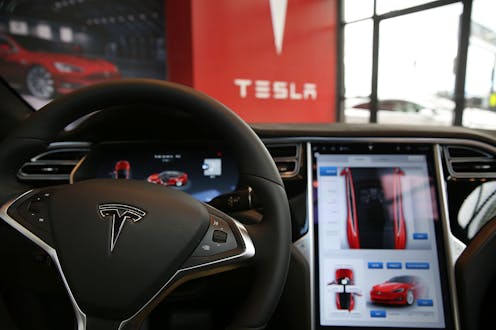What are automotive 'over-the-air' updates? A marketing professor explains
- Written by Vivek Astvansh, Professor of Marketing and Data Science, Indiana University

Whenever automakers discover that a vehicle has a defect[1] or does not comply with U.S. laws, they must notify the National Highway Traffic Safety Administration and mail a notice to each customer who owns or leases the affected vehicles. Automakers must also recall those cars, trucks or SUVs – which means they have to fix the defect across the entire fleet.
People with recalled vehicles usually have to schedule a visit to an authorized dealership, where a mechanic repairs the car.
But vehicles are increasingly high-tech contraptions. Although most recalls still require the replacement or repair of auto parts, such as air bags or brakes, a growing number of issues are resolved without any help from a mechanic.
All they require is an “over-the-air update[2].” That’s the technical term for what happens when you update any software program used by a device[3], whether’s it’s a smartphone or a sedan.
Over-the-air updates are especially common[4] for vehicles that run fully or partially on electricity instead of gasoline or another fuel[5]. These digital recalls require little or no effort. For example, Tesla regularly fixes[6] its cars by updating its software. Its drivers often don’t have to do a thing. In other cases, a Tesla owner simply has to tap[7] a few buttons on the car’s touchscreen.
According to the law, it doesn’t matter if safety-related fixes demand a software upgrade or a trip to the dealership. Either way, notifying the National Highway Traffic Safety Administration and all affected drivers is mandatory.
Why over-the-air updates matter
Electric vehicle sales nearly doubled[8] from about 300,000 in 2020 to more than 600,000 in 2021. EV sales rose another 76% in first quarter of 2022[9] even as sales of all new vehicles dropped by 15.7%.
U.S. EV sales could be on the verge of far more growth[10], which would make over-the-air updates increasingly common. But drivers[11] and investors[12] are raising an array of safety concerns that could put the brakes on the EV market’s expansion.
Serious problems have included electric vehicles failing to start[13], losing power[14] and catching fire because of battery defects[15].
Musk objects to the word ‘recall’
Tesla has pushed harder than its competitors[16] to rely primarily on over-the-air updates to fix problems with its electric vehicles. Its CEO, Elon Musk, has for years publicly questioned[17] the wisdom of calling over-the-air updates “recalls.”
In some cases, Tesla has conducted over-the-air updates to resolve safety defects without notifying the National Highway Traffic Safety Administration or Tesla owners[19] that a recall was underway.
Because that’s against the law[20], the agency has ordered Tesla to provide those details.
Tesla has used over-the-air updates to resolve, for example, issues with its windshield wipers[21] and seat belt chimes[22]. It has also used over-the-air updates[23] to address problems with[24] its partially automated driving systems[25]. Those features are the subject of a government investigation because of a spate of crashes with parked emergency vehicles[26] in which first responders were using warning signs, such as flashing lights or flares.
References
- ^ automakers discover that a vehicle has a defect (www.sundevilauto.com)
- ^ over-the-air update (www.pathpartnertech.com)
- ^ update any software program used by a device (www.devicechronicle.com)
- ^ especially common (www.caranddriver.com)
- ^ electricity instead of gasoline or another fuel (electrek.co)
- ^ Tesla regularly fixes (static.nhtsa.gov)
- ^ Tesla owner simply has to tap (static.nhtsa.gov)
- ^ Electric vehicle sales nearly doubled (www.energy.gov)
- ^ rose another 76% in first quarter of 2022 (insideclimatenews.org)
- ^ be on the verge of far more growth (www.fortunebusinessinsights.com)
- ^ drivers (www.cnn.com)
- ^ investors (www.cnbc.com)
- ^ electric vehicles failing to start (www.cnbc.com)
- ^ losing power (www.cnbc.com)
- ^ catching fire because of battery defects (www.cnn.com)
- ^ pushed harder than its competitors (www.cnn.com)
- ^ Elon Musk, has for years publicly questioned (www.motorbiscuit.com)
- ^ AP Photos/Florida Highway Patrol (newsroom.ap.org)
- ^ National Highway Traffic Safety Administration or Tesla owners (www.cnbc.com)
- ^ against the law (www.nytimes.com)
- ^ windshield wipers (static.nhtsa.gov)
- ^ seat belt chimes (static.nhtsa.gov)
- ^ over-the-air updates (static.nhtsa.gov)
- ^ problems with (www.autoblog.com)
- ^ automated driving systems (www.tesla.com)
- ^ crashes with parked emergency vehicles (www.cbsnews.com)
Authors: Vivek Astvansh, Professor of Marketing and Data Science, Indiana University

